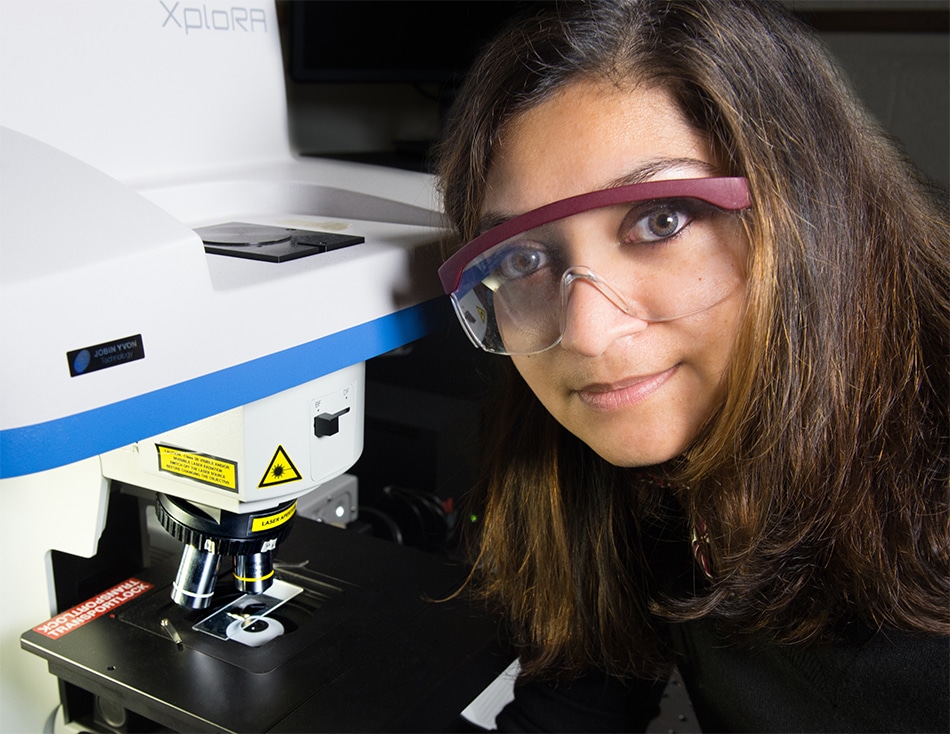 Image Credit: NASA/W. Hrybyk
Image Credit: NASA/W. Hrybyk
A NASA technologist and an MIT chemist have collaborated to develop a prototype spectrometer to detect light in space based on quantum-dot technologies. This could potentially revolutionise space-based spectrometry.
Quantum-dots (a type of semiconducting nanocrystal) were discovered in the late 20th century, and have been shown to absorb light of differing wavelengths based on their shape, size and chemical composition, affording them great promise in the realm of cameras, for example. The nanoscale of the quantum-dots allows for miniaturisation of the spectrometers used in NASA projects. NASA technologist Mahmooda Sultana is quoted as saying “It really could simplify instrument integration.”
Existing spectrometer technologies, though having seen considerable miniaturisation since their inception, remain generally large, bulky apparatuses. “Higher-spectral resolution requires long optical paths for instruments that use gratings and prisms,” Sultana said. “This results in large instruments.” With increased size of equipment comes increased cost of putting them in space to begin with, and so any reduction in size would be a significant bonus.
“With quantum-dots that act like filters that absorb different wavelengths depending on their size and shape, we can make an ultra-compact instrument. In other words, you could eliminate optical parts, like gratings, prisms and interference filters.”
Mahmooda Sultana - NASA
However, this is not the only cause for optimism in the new technology. The reduction in size of a quantum dot results in a decrease in the wavelength of light absorbed. “This makes it possible to produce a continuously tuneable, yet distinct, set of absorptive filters where each pixel is made of a quantum-dot of a specific size, shape, or composition. We would have precise control over what each dot absorbs. We could literally customize the instrument to observe many different bands with high-spectral resolution.”
Spectrometry allows for the identification of materials both in a light source, as well as in a medium in which it travels. Different chemicals produce different spectra of light that can be used to identify them, with different wavelengths of light being present identify the composition of stars. If the composition of a light source is known, it would then be possible to determine the composition of a medium, such as a gas cloud, to be determined by monitoring the wavelengths not present in the detected spectrum that were initially emitted.
When light passes through a gas cloud or planetary atmosphere, certain wavelengths are absorbed by different chemicals, with the degree of reduction in a specific wavelength detected by the spectrometer showing the quantity of absorbent material present in the sample. This can also be applied to light reflected from the Earth to allow studying of the atmosphere, particularly relevant with regards to current climate change fears.
Sultana is presently developing a 20-by-20 quantum-dot array prototype. The prototype will require testing by exposure to vibrations and thermal vacuum conditions, but will hopefully be sensitive to visible wavelengths of light required to image the sun as well as the aurorae. The technology could also be easily modified, however, to cover a wider range of wavelengths, for example ultra-violet and infrared.
MIT doctoral student Jason Yoo, working under Professor Moungi Bawendi, is investigating different techniques required to synthesise different precursor chemicals required for the formation of the quantum-dots before they are printed onto a substrate for use in the devices.
Though the technology is admittedly still in its infancy, there is hope for rapid development, according to Sultana. “We’re trying to raise its technology-readiness level very quickly. Several space-science opportunities that could benefit are in the pipeline.”
With necessity being the mother of invention, it could be possible that a fully-functioning quantum-dot-based spectrometer could soon be in operation in NASA missions.
References
Disclaimer: The views expressed here are those of the author expressed in their private capacity and do not necessarily represent the views of AZoM.com Limited T/A AZoNetwork the owner and operator of this website. This disclaimer forms part of the Terms and conditions of use of this website.